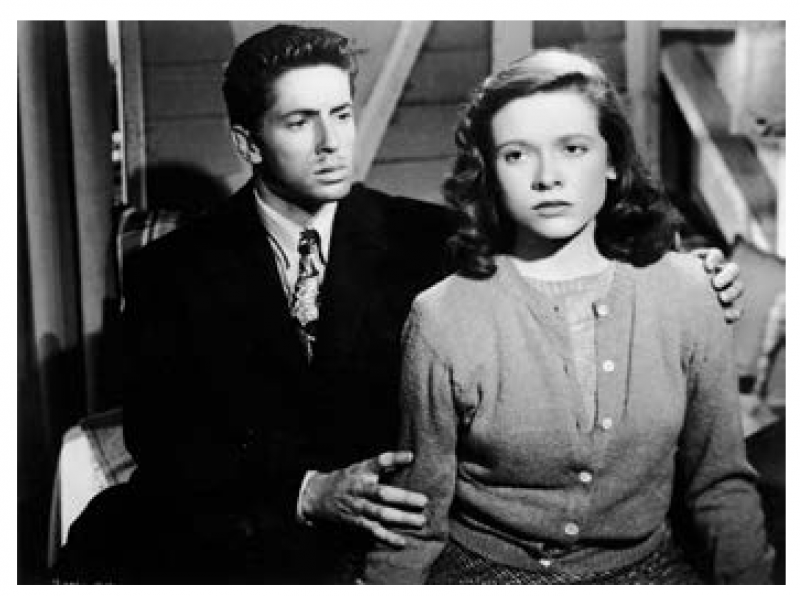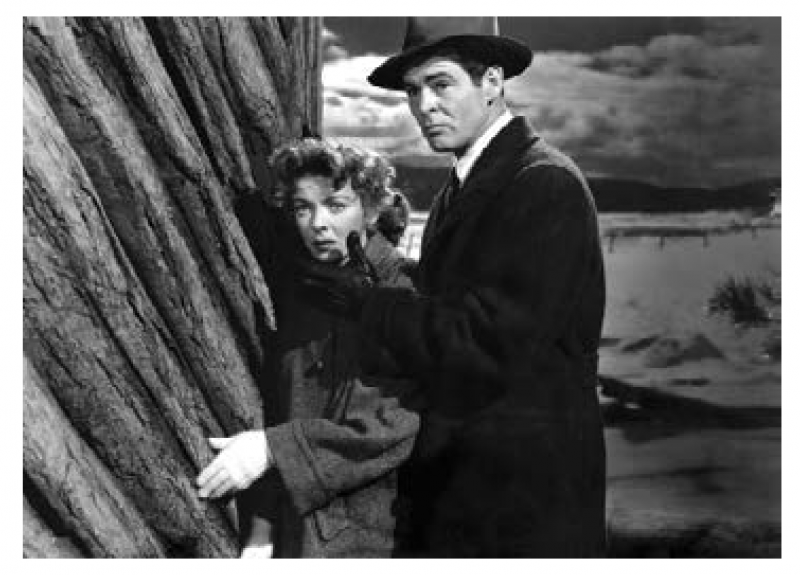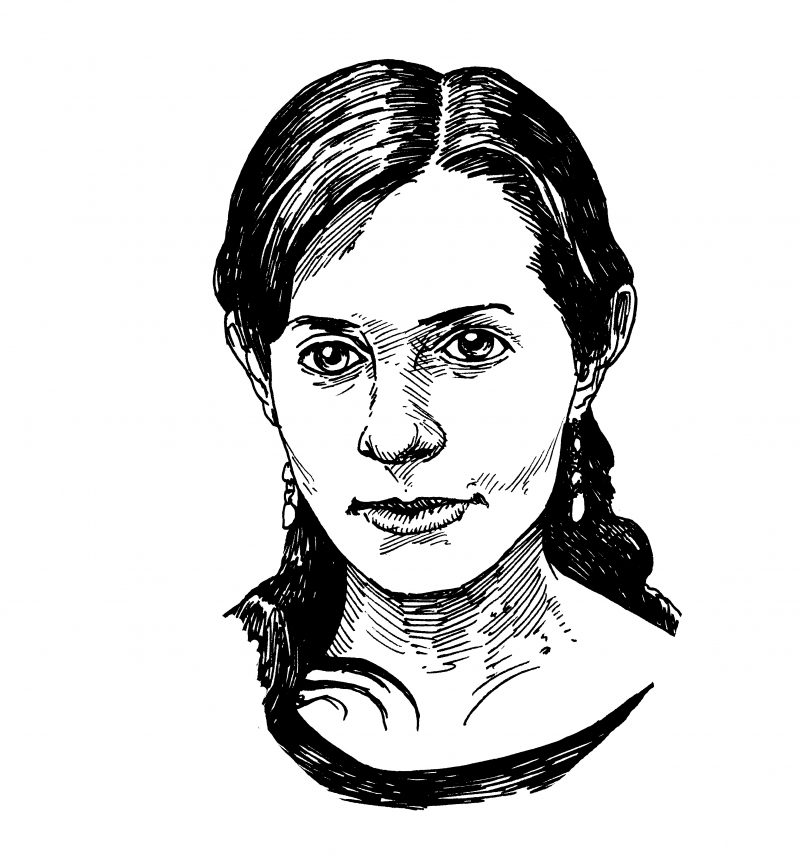Film noir is usually associated with urban settings, but in Imogen Sara Smith’s book In Lonely Places: Film Noir Beyond the City, she considers different noir locations—pristine suburbs, Western deserts, seedy border towns—to describe the genre as ultimately stemming from an existential condition. It’s an elegantly detailed tour through genre classics like Out of the Past (1947) and On Dangerous Ground (1952), in which Smith shows that no matter how far you run, you can’t escape yourself. Smith is also the author of Buster Keaton: The Persistence of Comedy.
—Aaron Cutler
THE BELIEVER: How did you start writing this book?
IMOGEN SARA SMITH: People always talk about the city as central, even necessary, to noir. But a few years ago it dawned on me that there are many noir films with nonurban settings. By coincidence, I had just watched several— I think they were Raw Deal (1948), Border Incident (1949), and The Hitch-Hiker (1953). So at first—just for fun—I was seeing how many of these films I could think of, and how many nonurban settings there were: the desert, the ocean, the road, small towns, the Mexican border. I saw this pattern as significant because in the postwar years there was a movement away from cities into the suburbs—a rejection of urbanism. This relates to the way in which, in the nonurban noirs, emptiness—a sense of people stranded in vacant spaces and of things coming apart—replaces the claustrophobic, encroaching, and labyrinthine spaces associated with urban noir. I started thinking about the way society is depicted—or rather, not depicted—in noir. Typical Hollywood films of the ’30s were full of crowds—there’s always an awareness of a larger society surrounding the characters and the potential for some kind of collective action. In noir, by contrast, it’s like people exist in a vacuum. When any group or institution is portrayed, it’s almost always corrupt or criminal, or it breaks down. People can’t be trusted; all relationships are vulnerable to betrayal. Alienation is at the heart of the noir condition. I think noir is so resonant in American culture because it delves into the dark side of our belief in independence and autonomy, which relates to a traditional distrust of cities, the importance of open space and mobility in the American imagination.
BLVR: Why did noir move away from communal spaces? Was it reflecting something that was happening in the culture?
ISS: Yes, especially the political climate. A lot of the writers, directors, and actors who were involved in film noir were left-wing, and many of them fell afoul of the House Un-American Activities Committee during the ’50s—Joseph Losey, Jules Dassin, Edward Dmytryk, Cy Endfield. I see noir in part as an expression of the disillusionment of the left, because during the 1930s, socialism and even communism seemed like they actually had a chance in America, as a response to the Depression. Then the war changed the whole mood of the country, and after that came the Cold War and the demonization of communism. Many noir films are bitter attacks on capitalism: they show organized crime as essentially indistinguishable from big business, or they show people warped by materialism until they turn to crime because they’re so desperate to achieve the American dream. The films are despairing and pessimistic, offering no solutions. They also reflect changes in technology and social life. During the postwar era, television replaced theaters, cars replaced public transportation, and the suburban “nuclear family” replaced urban communal living or rural extended families. Because people had appliances, they no longer needed servants, milkmen, icemen, and so forth. The glory of all this new technology was supposed to be that it made the family, or the individual, self-sufficient. But what noir reflects is that it also made life lonelier, and made people less trusting of each other.
BLVR: What about the relationship between the sexes? How is that portrayed in noir?

ISS: The standard account of the femme fatale figure is that the trope grew out of male anxiety about women’s greater independence during the war. But the femme fatale is never a woman who works. And she’s hardly an independent woman; she uses men to get what she wants, exploiting her sexual wiles and manipulating men by presenting herself as weak. The postwar years were a time when women were pressured to leave the workplace, and America moved back toward a society where women depended entirely on men for their livelihood. In noir, this becomes an ugly equation: women use sex to get money, men use money to get sex, and both sides lose. There is a whole category of domestic noirs that deal with how women react to their limited lives. Household interiors appear oppressive or threatening, showing the suburban dream home as a jail. Films like Leave Her to Heaven (1945), The Strange Affair of Uncle Harry (1945), and Angel Face (1952) are all set in versions of an ideal house and feature atypical femmes fatales who are motivated not by greed and selfishness but by an obsessive need for love—a regressive inability to grow beyond a childlike dependence on a father figure or brother figure. Another common plot has a female protagonist imprisoned in her home and menaced by a man, often her husband, which ironically undermines the notion of marrying for security. On the other hand, some of the most positive versions of male-female relationships in noir come in the subgenre of road movies that follow the Bonnie and Clyde formula, like They Live by Night (1948), Gun Crazy (1950), and Tomorrow Is Another Day (1951). In these intensely romantic films, the shared experience of living outside the law and society brings couples closer than anything else. The lovers can trust only one another, but in the end the society they abandoned destroys them.
BLVR: How did the style of acting in film noir express the psychology of these characters?

ISS: I think the acting style in noir is largely about the dichotomy between masks and naked emotions. The mask is mostly a performance of the hard-boiled persona—an intensely stylized self-presentation that is largely about protection, not revealing any vulnerabilities or letting people know your real thoughts. The poker face, clothing, accessories, and props are very important in this performance—all masking and guarding the wearer. But noir is really about what goes on beneath the surface, about what happens when the performance fails and the truth is revealed.
The hard-boiled mask is very much an urban style, and without oversimplifying, I think one can say that nonurban settings bring out more unguarded as well as more physically and emotionally active performances, whether it’s in the openness and sincerity of small-town “innocents”—for instance the beautifully honest performance by Phyllis Thaxter as the wife of a struggling fishing-boat captain in The Breaking Point (1950)—or the naked desperation of people pushed to extremes in deserts or the wilderness, like the characters played by Edmond O’Brien and Frank Lovejoy in Ida Lupino’s The Hitch-Hiker. There’s a greater physicality, sensuality, and naturalness in the nonurban films, and less of a stylish smoke screen.
BLVR: How did you structure your book?
ISS: I structured it geographically, so it starts with the city and moves into increasingly remote, wild, or deserted regions—a largely westward movement. Travel is important to the book. Noir consistently undermines the American love affair with the road and the belief that travel equals freedom—that you can always get a new start in a different place. In noir, no place is pure, and there’s no refuge to be found in unspoiled wilderness or small-town innocence. The notion that you can never get away from yourself runs through many of these films, so the final location I discuss is the mind. Noir is ultimately about interior and subjective states, and about people trapped within their own obsessive memories, fears, or desires. Noir is also mainly about people who pursue their own interests outside the bounds of society—and how they are destroyed by society. It seems to simultaneously lament the excesses of individualism and to loathe the crowd—when crowds do appear, they’re usually lynch mobs. This sounds like a contradiction, but perhaps the essence of noir is that there’s no right answer: you’re damned either way.





